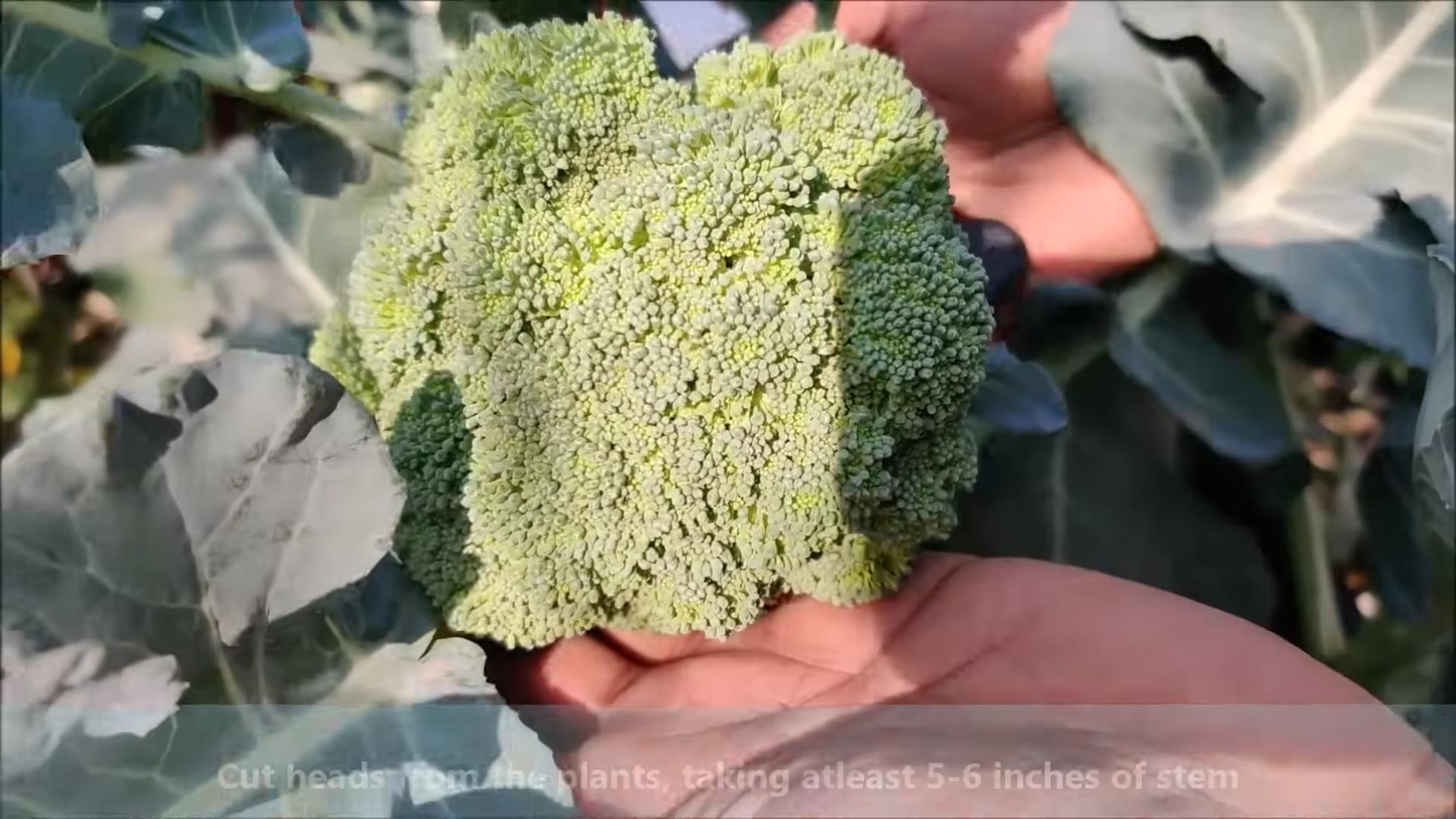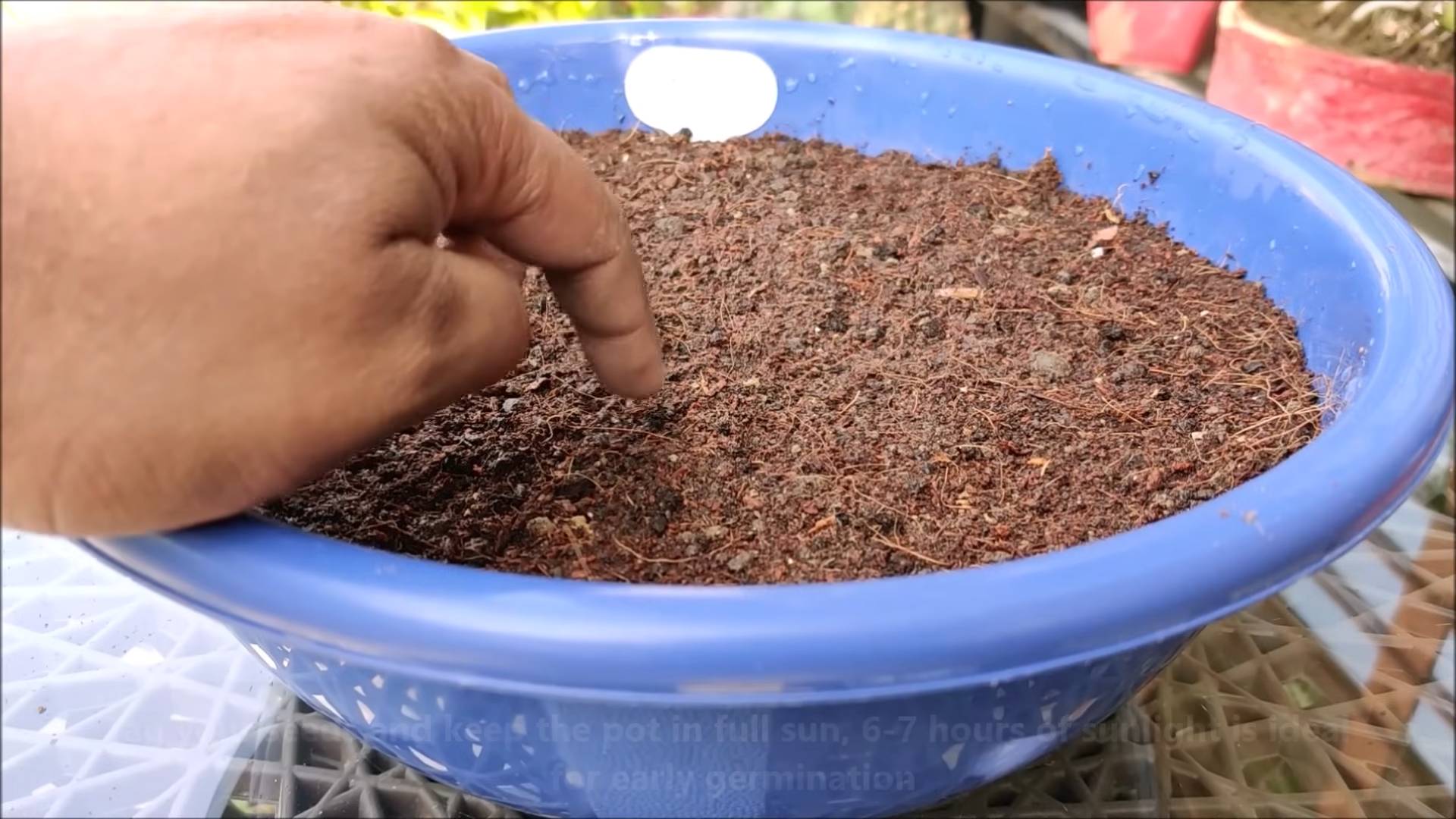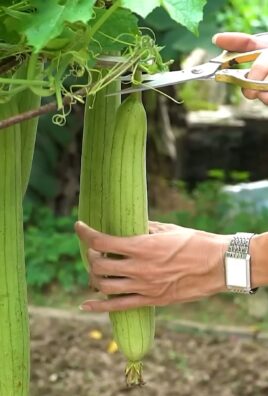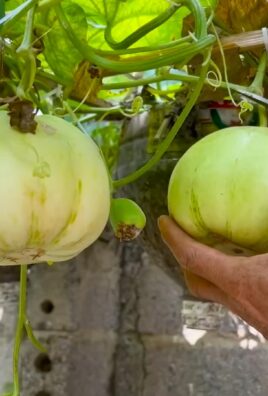Grow Broccoli at Home – and unlock the secrets to fresh, delicious, and nutritious harvests right in your backyard! Have you ever dreamed of strolling into your garden and picking the perfect head of broccoli for dinner? It’s more achievable than you might think, and this DIY guide will show you how. For centuries, cultivating your own food has been a cornerstone of self-sufficiency and a connection to the earth. From ancient Roman gardens to the victory gardens of World War II, growing your own vegetables has always been a way to ensure quality and freshness.
But in today’s busy world, why should you bother learning to grow broccoli at home? Well, for starters, think about the taste! Homegrown broccoli bursts with flavor that you simply can’t find in store-bought varieties. Plus, you control everything – from the soil to the pest control – ensuring a healthier and more sustainable food source for you and your family. I’m going to share some simple yet effective tricks and hacks that will transform your garden into a broccoli-producing powerhouse, even if you’re a complete beginner. Get ready to ditch the grocery store broccoli and embrace the joy of harvesting your own!

Growing Broccoli at Home: A Beginner’s Guide
Hey there, fellow gardening enthusiasts! Ever dreamt of plucking fresh, vibrant broccoli heads straight from your backyard? Well, dream no more! Growing broccoli at home is surprisingly achievable, even for beginners like I once was. It just takes a little planning, patience, and the right know-how. This guide will walk you through every step, from seed to harvest, ensuring you’ll be enjoying homegrown broccoli in no time.
Choosing the Right Broccoli Variety
First things first, let’s talk broccoli varieties. There are tons to choose from, and the best one for you will depend on your climate and growing season. Here are a few popular options:
* ‘Waltham 29’: A classic, reliable variety that’s known for its good flavor and heat tolerance. It’s a great choice for beginners.
* ‘DiCicco’: This variety produces a large main head followed by numerous side shoots, giving you a longer harvest period.
* ‘Green Magic’: A fast-maturing variety that’s perfect if you’re short on time or live in a region with a short growing season.
* ‘Calabrese’: Another popular variety that produces large, dark green heads.
Consider your local climate and the length of your growing season when making your choice. Seed packets usually provide helpful information about each variety’s specific needs.
Starting Broccoli Seeds
Broccoli is a cool-season crop, meaning it thrives in cooler temperatures. In most regions, you’ll want to start your seeds indoors about 6-8 weeks before the last expected frost.
1. Gather Your Supplies: You’ll need seed starting trays or small pots, seed starting mix (a light, well-draining soil mix specifically designed for seedlings), broccoli seeds, a spray bottle, and a heat mat (optional, but helpful).
2. Prepare the Seed Starting Mix: Moisten the seed starting mix with water until it’s damp but not soggy.
3. Sow the Seeds: Fill your seed starting trays or pots with the moistened mix. Make a small indentation (about 1/4 inch deep) in the center of each cell or pot. Place 2-3 broccoli seeds in each indentation.
4. Cover the Seeds: Gently cover the seeds with a thin layer of seed starting mix.
5. Water Gently: Use a spray bottle to mist the surface of the soil. Avoid overwatering, as this can lead to damping-off disease.
6. Provide Warmth and Light: Place the seed starting trays or pots on a heat mat (if using) and under grow lights or in a sunny window. Broccoli seeds need warmth and light to germinate. Aim for a temperature of around 70-75°F (21-24°C).
7. Keep the Soil Moist: Check the soil moisture daily and mist with water as needed to keep it consistently moist but not waterlogged.
8. Thin the Seedlings: Once the seedlings have emerged and have a couple of true leaves (the second set of leaves), thin them to one seedling per cell or pot. Choose the strongest, healthiest-looking seedling and snip off the others at the soil line.
Transplanting Broccoli Seedlings
Once your broccoli seedlings have developed several true leaves and are about 4-6 inches tall, they’re ready to be transplanted outdoors. This is usually about 2-3 weeks after germination.
1. Harden Off the Seedlings: Before transplanting, you’ll need to “harden off” the seedlings. This process gradually acclimates them to outdoor conditions. Start by placing the seedlings outdoors in a sheltered location for a few hours each day, gradually increasing the amount of time they spend outside over the course of a week.
2. Prepare the Garden Bed: Choose a sunny location in your garden that receives at least 6 hours of sunlight per day. Broccoli prefers well-drained soil that is rich in organic matter. Amend the soil with compost or well-rotted manure before planting.
3. Space the Seedlings: Space the broccoli seedlings about 18-24 inches apart in rows that are 24-36 inches apart. This will give them enough room to grow and mature.
4. Plant the Seedlings: Dig a hole that is slightly larger than the root ball of the seedling. Gently remove the seedling from its pot and place it in the hole. Backfill with soil and gently firm the soil around the base of the plant.
5. Water Thoroughly: Water the newly transplanted seedlings thoroughly.
6. Mulch: Apply a layer of mulch around the broccoli plants to help retain moisture, suppress weeds, and regulate soil temperature. Straw, wood chips, or shredded leaves are all good options.
Caring for Your Broccoli Plants
Once your broccoli plants are in the ground, it’s important to provide them with proper care to ensure a healthy and productive harvest.
1. Watering: Broccoli needs consistent moisture, especially during head formation. Water deeply and regularly, especially during dry spells. Aim for about 1-1.5 inches of water per week.
2. Fertilizing: Broccoli is a heavy feeder, so it benefits from regular fertilization. Apply a balanced fertilizer (such as 10-10-10) every 2-3 weeks, following the instructions on the fertilizer package. You can also side-dress with compost or well-rotted manure.
3. Weeding: Keep the garden bed free of weeds, as they can compete with the broccoli plants for nutrients and water. Hand-pull weeds regularly or use a hoe to cultivate the soil.
4. Pest Control: Broccoli is susceptible to several pests, including cabbage worms, aphids, and flea beetles. Inspect your plants regularly for signs of pests and take action promptly.
* Cabbage Worms: These green caterpillars can devour broccoli leaves. Handpick them off the plants or use Bacillus thuringiensis (Bt), a natural insecticide that is effective against cabbage worms.
* Aphids: These small, sap-sucking insects can weaken broccoli plants. Spray them off with a strong stream of water or use insecticidal soap.
* Flea Beetles: These tiny beetles can create small holes in broccoli leaves. Cover the plants with row covers to prevent flea beetles from reaching them.
5. Disease Control: Broccoli can also be affected by several diseases, including clubroot and black rot.
* Clubroot: This soilborne disease causes swollen, distorted roots. Prevent clubroot by planting broccoli in well-drained soil and rotating your crops.
* Black Rot: This bacterial disease causes yellowing and browning of the leaves. Prevent black rot by using disease-free seeds and avoiding overhead watering.
Harvesting Your Broccoli
The moment you’ve been waiting for! Harvesting your homegrown broccoli is incredibly rewarding.
1. Timing is Key: Broccoli is ready to harvest when the head is firm, tight, and a deep green color. The individual florets should be tightly closed. If the florets start to open and turn yellow, it’s time to harvest immediately.
2. Cut the Head: Use a sharp knife to cut the main head of broccoli from the plant, leaving about 5-6 inches of stem.
3. Encourage Side Shoots: After harvesting the main head, the plant will often produce side shoots. These smaller heads can be harvested over a longer period of time.
4. Enjoy Your Harvest: Freshly harvested broccoli is delicious steamed, roasted, stir-fried, or eaten raw in salads.
Troubleshooting Common Broccoli Problems
Even with the best care, you might encounter some challenges when growing broccoli. Here are a few common problems and how to address them:
* Small Heads: Small broccoli heads can be caused by a variety of factors, including insufficient sunlight, poor soil, lack of water, or pests. Make sure your broccoli plants are getting enough sunlight, water, and nutrients. Control pests and diseases promptly.
* Bolting: Bolting (premature flowering) can occur when broccoli plants are exposed to hot weather or stress. Choose heat-tolerant varieties and provide shade during hot spells.
* Yellowing Leaves: Yellowing leaves can be a sign of nutrient deficiency, disease, or pest infestation. Check the soil pH and nutrient levels. Inspect the plants for signs of pests or diseases and take appropriate action.
* Leggy Seedlings: Leggy seedlings (tall, spindly seedlings) are often caused by insufficient light. Make sure your seedlings are getting enough light, either from grow lights or a sunny window.
Extending Your Broccoli Harvest
Want to enjoy homegrown broccoli for as long as possible? Here are a few tips for extending your harvest:
* Succession Planting: Plant broccoli seeds every 2-3 weeks to ensure a continuous harvest.
* Choose Varieties with Side Shoots: Varieties like ‘DiCicco’ produce numerous side shoots after the main head is harvested,

Conclusion
So, there you have it! Growing broccoli at home, while it might seem daunting at first, is an incredibly rewarding experience that puts fresh, nutritious produce right at your fingertips. We’ve walked you through the key steps, from selecting the right variety to warding off common pests, and hopefully, demystified the process along the way.
Why is this DIY trick a must-try? Because store-bought broccoli simply can’t compare to the vibrant flavor and crisp texture of homegrown. Plus, you have complete control over what goes into your garden, ensuring your broccoli is free from harmful pesticides and chemicals. Imagine the satisfaction of serving a meal featuring broccoli you nurtured from seed to harvest! It’s a feeling of accomplishment and a commitment to healthier eating.
But the benefits extend beyond just taste and health. Gardening is a fantastic stress reliever, a way to connect with nature, and a fun activity for the whole family. Getting your hands dirty and watching your broccoli plants thrive is a truly therapeutic experience.
Ready to take your broccoli growing to the next level? Consider these variations and suggestions:
* Succession Planting: Plant new broccoli seeds every few weeks to ensure a continuous harvest throughout the growing season.
* Companion Planting: Plant herbs like rosemary and thyme near your broccoli to deter pests naturally. Marigolds are also excellent companion plants.
* Container Gardening: If you’re short on space, broccoli can be successfully grown in large containers. Just make sure they have adequate drainage.
* Experiment with Varieties: Don’t be afraid to try different broccoli varieties, such as Romanesco or purple sprouting broccoli, to find your favorites.
* Broccoli Raab: Harvest the leaves and stems of your broccoli plants for a delicious and nutritious side dish.
We’re confident that with a little patience and care, you can successfully grow broccoli at home and enjoy the fruits (or rather, vegetables) of your labor. Don’t be discouraged by initial setbacks; gardening is a learning process, and every season brings new opportunities to improve.
Now, it’s your turn! We encourage you to give this DIY trick a try. Start small, learn as you go, and most importantly, have fun! We’d love to hear about your experiences. Share your photos, tips, and challenges in the comments below. Let’s build a community of home broccoli growers and inspire others to embrace the joys of gardening. Happy growing!
Frequently Asked Questions (FAQ)
What is the best time of year to plant broccoli?
The best time to plant broccoli depends on your climate. In general, broccoli is a cool-season crop, meaning it thrives in temperatures between 60°F and 70°F (15°C and 21°C). For spring harvests, start seeds indoors 6-8 weeks before the last expected frost. Transplant seedlings outdoors 2-3 weeks before the last frost. For fall harvests, start seeds indoors in mid-summer and transplant seedlings outdoors in late summer or early fall. Check your local frost dates to determine the optimal planting time for your region.
How much sunlight does broccoli need?
Broccoli requires at least 6 hours of direct sunlight per day to grow properly. Choose a planting location that receives ample sunlight throughout the day. If you’re growing broccoli in containers, make sure to place them in a sunny spot. Insufficient sunlight can result in leggy plants with small heads.
What kind of soil is best for growing broccoli?
Broccoli prefers well-drained, fertile soil that is rich in organic matter. The ideal soil pH is between 6.0 and 7.0. Before planting, amend your soil with compost or other organic matter to improve drainage and fertility. You can also add a slow-release fertilizer to provide essential nutrients to your broccoli plants.
How often should I water my broccoli plants?
Broccoli plants need consistent moisture to thrive. Water deeply and regularly, especially during dry periods. Aim to keep the soil consistently moist but not waterlogged. A good rule of thumb is to water when the top inch of soil feels dry to the touch. Mulching around your broccoli plants can help retain moisture and suppress weeds.
What are some common pests and diseases that affect broccoli?
Broccoli is susceptible to several pests and diseases, including cabbage worms, aphids, flea beetles, clubroot, and downy mildew. To prevent pest and disease problems, practice good garden hygiene, such as removing plant debris and weeds. You can also use row covers to protect your plants from pests. If you encounter pests or diseases, treat them promptly with appropriate organic or chemical controls.
How do I know when my broccoli is ready to harvest?
Broccoli is ready to harvest when the head is firm, tight, and dark green. The individual florets should be tightly closed. If the florets start to open and turn yellow, it’s a sign that the broccoli is overripe. Cut the main head of broccoli with a sharp knife, leaving a few inches of stem. Side shoots will often develop after the main head is harvested, providing you with additional broccoli for several weeks.
Can I grow broccoli in containers?
Yes, broccoli can be successfully grown in containers. Choose a large container that is at least 12 inches in diameter and 12 inches deep. Make sure the container has drainage holes to prevent waterlogging. Use a high-quality potting mix that is well-draining and fertile. Water regularly and fertilize every few weeks with a balanced fertilizer.
What is broccoli raab, and how is it different from regular broccoli?
Broccoli raab, also known as rapini, is a leafy green vegetable that is related to broccoli. It has a slightly bitter, peppery flavor. Unlike regular broccoli, broccoli raab is harvested for its leaves, stems, and small flower buds. It is often used in Italian cuisine and can be sautéed, steamed, or grilled.
How can I prevent my broccoli from bolting (going to seed)?
Bolting is when a plant prematurely flowers and goes to seed. It is often caused by stress, such as heat, drought, or nutrient deficiencies. To prevent broccoli from bolting, plant it at the right time of year, provide adequate water and nutrients, and protect it from extreme temperatures. Mulching around your plants can help regulate soil temperature and retain moisture.
Is it possible to grow organic broccoli at home?
Absolutely! Growing organic broccoli at home is a great way to ensure that your produce is free from harmful pesticides and chemicals. Use organic seeds and potting mix, amend your soil with compost or other organic matter, and use organic pest and disease control methods. With a little effort, you can grow delicious and healthy organic broccoli in your own backyard.





Leave a Comment